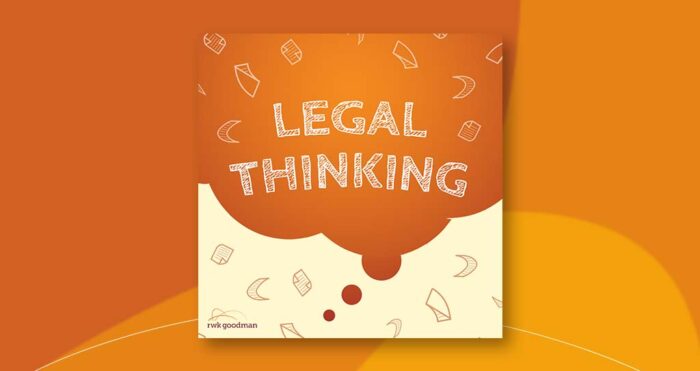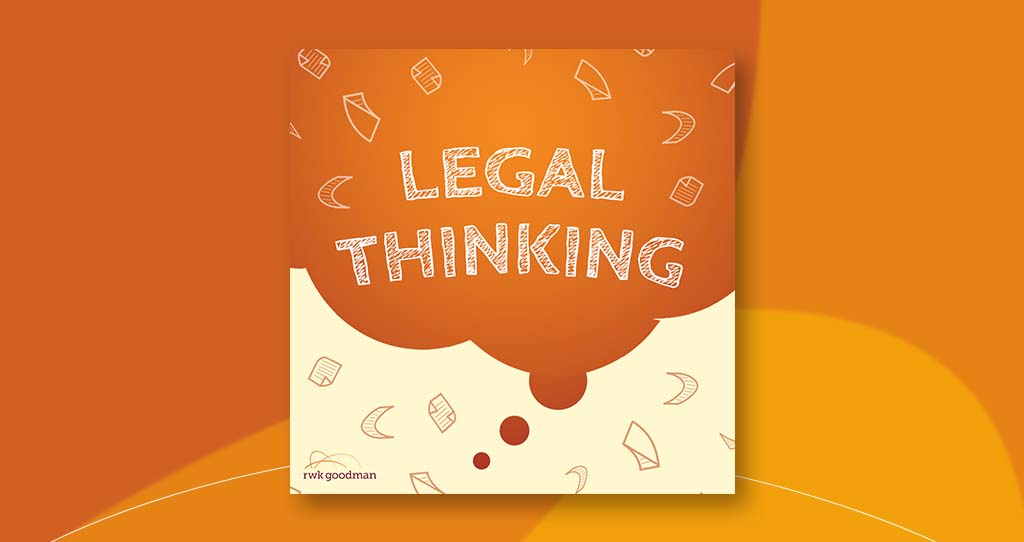What you need to know about myocardial infarction | Legal Thinking Podcast
So today we are talking about the treatment of myocardial infarction (hopefully I’m pronouncing that correctly) and its relation to coronavirus so as some people are seeing - when coronavirus first became a thing the relationship between COVID infections and subsequent myocarditis was noted and sometimes they could develop myocarditis and basically, I guess, is a relation to myocardial infarction is in there somewhere.
First question is for you Stephen, so if you could tell us a bit about myocardial infarctions. How do they present, in who and what should doctors be looking out for?
Dr. Stephen Hoole: OK so thanks very much. You have pronounced it correctly! So myocardial infarction is a medical emergency and patients present unwell, unsurprisingly. They commonly experience chest discomfort which they classically describe as a tightening, goes to the jaw, down the arm but it’s associated with things like breathlessness, sweatiness, nausea and vomiting. Sometimes palpitations and sometimes dizziness. I have to say it’s important to remember that that’s the typical presentation but patients may present atypically and particularly woman and people of ethnic minority may not actually describe the classic symptoms. So clinicians should be alerted to the possible diagnosis in patients that have risk factors and I’m going to touch on those because I think that’s important. Obviously as we get older the risk of myocardial infarction goes up, male sex is also a risk factor as is diabetes mellitus, smoker, hypertension, hypercholesteremia and family history but those are all the things that are taught in medical school but I what I think it less well recognised is that inflammatory conditions such as rheumatoid arthritis for example, can increase your risk of having a myocardial infarction. Arthrosclerosis is an inflammatory condition and any inflammatory…any inflammation can cause plaque rupture. So that’s how patients present. The signs are quite…you know patients just look unwell and I don’t think you necessarily need a medical degree to know when someone’s having a medical problem like a heart attack. They look pale, they look ashen and grey, they may be struggling, they look unwell but they can have a number of other signs, high or low heart rate, high or low blood pressure, but those are kind of the classic symptoms and signs.
Ok yeah, so I was just going to pass over to Joachim now, probably, he’s a member of our medical negligence team and I think he had some questions as well.
Joachim Stanley: Yeah, well moving on from that logically, we’ve not got the presentations…a patient presentation profile to work with. How do you then confirm the diagnosis? What do you look for and what tests are done?
Dr. Stephen Hoole: The key diagnostic test and it’s often done by paramedic crews or immediately in the emergency department, is the 12 lead ECG and we are looking specifically for ST elevation to…
Joachim Stanley: Can you take us through what an ECG is?
Dr. Stephen Hoole: So it’s an electrocardiogram and it’s taking an electrical recording of the heart from multiple different leads that are attached to the chest and by studying those leads you can diagnose ST elevation which is a sign that there’s a hear artery that’s occluded and it will give you some idea of the territory that may be affected and that’s the key diagnostic test that usually results in, if ST elevation is present, with activation of, what we call, a primary PCI pathway, that’s an emergency transfer to a heart attack centre for emergency invasive coronary angiography.
Joachim Stanley: And I think I’m right in saying that it’s important to take a blood test as well initially, is that right?
Dr. Stephen Hoole: You can. Often it takes a bit longer for the blood tests to come back and the blood tests you’re talking about is Troponin. Sometimes if the diagnosis isn’t clear on the ECG, clinicians might wait for a blood test but it’s not necessary for the diagnosis of an ST elevation, myocardial infarction. Frequently we’ll have a patient transferred to us who has not had a blood test but who has classic presentation with the ECG changes and we’ll accept them and treat them without a blood test.
Joachim Stanley: Ok so the patient’s now in hospital and we’re going to assume that the ST segment of the ECG is abnormal. What sort of treatment is then offered to that patient?
Dr. Stephen Hoole: So, I mean, patients will have medical therapy to start with and they might have that in the ambulance on route and the key thing that we’re looking for them to have is dual anti-platelet therapy loading doses of aspirin and usually the Ticagrelor or Prasugrel although we can sometimes use Clopidogrel. So that prepares them, if you like, for what they need which is often the infarct related artery being opened with a stent. So they go directly to the cath lab. They have an invasive coronary angiogram, usually done through the wrist artery. We identify the blocked blood vessel in the heart and then we open it up with balloons and balloon mounted stents.
Joachim Stanley: And after the stenting has occurred, I presume the aim of this would be to widen the locked coronary artery, or arteries plural.
Dr. Stephen Hoole: That's right.
Joachim Stanley: Can the patient typically expect to go back to a pretty normal lifestyle and do they have to watch out for anything after this?
Dr. Stephen Hoole: So opening the artery as quickly as possible is really important to minimise infarct size and if we’re able to do this, it is a time dependent treatment, so if we’re able to do this quickly enough, we can salvage myocardium and as a result the heart attack is smaller and then patients hopefully will have a better recovery with a reduced risk of downstream events and the downstream events are heart failure or rhythm disturbances. For the vast majority of patients if we do…we are able to open the infarct related artery will make a reasonably good recovery and should, hopefully be able to lead a reasonably normal life afterwards.
Joachim Stanley: And myocardium is synonymous with heart muscle isn’t it?
Dr. Stephen Hoole: That’s right, yeah.
Joachim Stanley: Right. So it’s time dependent. So the more swiftly one acts, the greater the chance, I guess from what you’re saying, of salvaging as much myocardium as possible because the damage to it from not having blood flow will be minimised. Patients have a relatively normal lifestyle after that and do they have to be on the lookout for any symptoms afterwards? Is there anything they need to be aware of?
Dr. Stephen Hoole: Well they usually started on some medications to, what we call secondary presentation medications to reduce the risk of it happening again and just help the heart cope with what has been some damage. So there…and you’re touching upon a really important thing which is that patients go to rehabilitation and they get the support they need to both understand what’s happened to them and what changes they need to make to their lifestyle. For example, if they’re smoking, if they have an unhealthy lifestyle, what they can do to help themselves. So there is some education around post heart attack care.
But they don’t tend to be followed up in local cardiology services and then with their primary healthcare physician. So that’s the usual management afterwards but yes, you know, part of that education is what to look out for if they’re breathless, if they have more chest pain, if they have palpitations, dizziness or blackouts. These are all things that we’re reviewing at clinic follow up.
Joachim Stanley: Sure. And Ed touched on the relationship between coronavirus when it first became known and a condition called myocarditis. Myocarditis, as I understand it, and do please correct me if I’ve misunderstood it, is characterised by swelling in and around the heart and, I suppose it would be helpful for our listeners for you to take us through how the relationship between coronavirus and myocarditis came to be known and what the research demonstrated or appeared to demonstrate at the time.
Dr. Stephen Hoole: Yeah. I think it’s useful just to take a step backwards. I mean we’re obviously understanding quite a bit more about coronavirus than we perhaps did in the first few months of 2020 when it started to present itself. I think what we know is there is a direct toxic affect of…of coronavirus, COVID-19 on the heart and that’s due to direct viral binding and release from the myocardium but there’s also this indirect inflammatory response which you’ve mentioned. I’ve mentioned about plaque instability and rupture in inflammatory conditions because it is an inflammatory condition and that…that’s one way that the heart is damaged by coronavirus and actually that didn’t get so much press as the second thing which you’ve mentioned which is that myocardium inflammation or myocarditis. I have to say that I think the lay media and also there was a lot of case reports around the time about myocarditis led to this being, almost at the forefront of people’s minds when they were faced with a case of patient with chest pain and some ST changes but actually in reality it’s still a reasonably rare diagnosis and subsequently we’ve learned that actually true myocarditis probably is still quite rare in the COVID cases.
The other ways that the COVID can damage the heart, micro…micro thrombosis. If they get a disseminated intravascular coagulation. They also can get stress induced myocardial damage just simply by a patient being very unwell. Supply and demand is mismatched and so blood supply can’t meet the increased demands of a patient that is systemically very unwell with a high heart rate and high blood pressure and as a result they can have an infarct.
So there are a number of different pathological mechanisms so COVID can affect the hear whereas myocarditis is only one of those things.
Joachim Stanley: Ok. It was fascinating that you mentioned that myocarditis and underlying vascular issues in the heart, so presumably for the most part atherosclerotic disease can act synergistically if I’ve understood that correctly. Does that mean that, you know, if you have atherosclerosis there then the risk of something being set off is higher?
Dr. Stephen Hoole: I think what we’ve notice from epidemiological studies is that if you have cardiovascular disease already and then you develop COVID, those patients had a worse prognosis and that’s maybe because it’s a surrogate for patients that have…who have older age, who have other comorbidities. So usually the sicker COVID patients had quite a lot of comorbidity and including cardiovascular disease but the other thing is that if patients develop cardiovascular complications of COVID, again their prognosis was worse. So I think that’s to bear in mind. To my mind plaque rupture and a communal garden heart attack was still a common scenario in the COVID era and we shouldn’t forget…we shouldn’t forget that.
Joachim Stanley: So following on from what you’re saying I think that even at the height of coronavirus as a pandemic, it would’ve been incumbent on treating clinicians to rule out a myocardial infarction in the first instance when they’ve got a patient in with quite worrying chest symptoms, is that right?
Dr. Stephen Hoole: I think that’s correct. I mean the diagnosis of myocarditis, I mean, it has a very similar presentation in many respects to, you know, as I say, a heart attack and it’s quite difficult to diagnose clinically the diagnostic tests that we’ve mentioned with ECG for example, may look…may look identical so you do need to do this. I think you do need to do an invasive or non invasive coronary angiogram in the vast majority of patients. So it should be encouraged. It’s really, myocarditis in my mind is a diagnosis of exclusion. You should exclude the very important and time dependent time diagnosis of myocardial infarction before you’re starting to consider slightly rarer myocarditis.
Joachim Stanley: And the next obvious question is what happens if you fail to exclude it?
Dr. Stephen Hoole: Well as I said it’s a time dependent treatment opening the artery and patients, if you miss the diagnosis and start treating myocarditis which is mainly supportive treatment, there really isn’t a direct treatment for myocarditis, you miss the opportunity to salvage myocardium that may be caused by a heart attack and as a result patients have bigger heart attacks and have worse outcomes so they have more heart failure, not arrythmia and their prognosis is impacted. So it is one of those diagnoses that, you know, you should really be, in my view, you should be sure that the patient doesn’t have a myocardial infarction before you’re thinking about the diagnosis of myocarditis and the only way to be sure is to do so some form of coronary imaging.
Joachim Stanley: Right. So patients have to be treated as if they have myocardial infarction at first instance and then one can come onto consider whether myocarditis is an issue or not but that also brings us onto the question of how patients actually presented when the pandemic was going on. In your clinical experience were patients often noticeably sicker when they turned up to hospital than had previously been the case. Do they present with more issues?
Dr. Stephen Hoole: Well I think there was a reticence with patients to present to hospital, both to avoid getting COVID but also to help the NHS and so we were seeing later presentations. So…and that obviously in itself resulted in sicker patients arriving. There were clearly pathway delays. Our primary PCI pathway, although it was fully open throughout the pandemic because we had to use protective equipment, there were delays in delivering that so the delays, if you like, of delivering heart attack care did result in sicker patients but we were seeing odd presentations and it was more out of hospital cardiac arrests, the patients were sicker, and we were seeing strange things like multiple plaque rupture. Normally a heart attack may just have one culprit and we…and I think many others saw patients with multiple culprit vessels that had ruptured plaque.
Joachim Stanley: Presumably meaning that there’s a greater chance of them needing open heart surgery and coronary artery bypass grafting rather than a closed heart repair I guess.
Dr. Stephen Hoole: I think it just speaks to the systemic insult that the patient was…was experiencing. Those patients didn’t necessarily have bypass. Patients with COVID did very poorly with bypass and so these were all treated percutaneously.
And they didn’t tolerate, if you like, the second injury of going onto to a heart…heart lung bypass machine and those patients did very poorly so we were not treating patients with bypass although you could argue that their anatomy was such that they might have benefited but reality was that they didn’t tolerate going on bypass at all.
Also because they have multi…lots more multi organ failure and as I mentioned about this micro vascular thrombosis, these patients were really very sick and if it’s like presenting with a heart attack but had lots of other problems with other organ systems that resulted in a very high mortality.
Joachim Stanley: Well that’s the next question I was going to ask actually which is so was microvascular thrombosis something which affected other systems in the body.
Dr. Stephen Hoole: Well yeah, well they had multi organ failure affecting the kidney and they often had kidney failure.
They had basically an acute respiratory distress syndrome picture and these patients, the very sick ones, the ones that had severe COVID were very unwell.
Joachim Stanley: Yeah and you and I had done cases involving treatment which occurred during this period and I was probably under the impression you’ve got quite strong views about what did happen and what should have happened. What do you think are the major learning points for clinicians and indeed everybody else coming out of this.
Dr. Stephen Hoole: You know I think we’ve been learning about COVID and I think we understand it a lot more, two or three years down the line, than we did. I think common things are common and I think we now recognise that COVID can increase the risk of communal garden heart attack and we should be excluding that diagnosis before reaching for a diagnosis of myocarditis which, undoubtedly was associated with COVID but it was down the decision tree, down the diagnostic decision tree from heart attacks and I think we shouldn’t forget that heart attacks are a major killer, were a major killer before and remain a major killer afterwards, after COVID and that really helped through the pandemic and we need to continue to screen our patients and make those diagnoses because it’s actually something that we could do something about and we can actually treat heart attacks effectively. We have effective treatments for it but unfortunately some diagnoses were missed.
Joachim Stanley: Yeah, no I think you touch on a very important point and if anyone’s listening to this and, god forbid, at some point later you develop any sort of chest symptoms then for goodness sake, pick up the phone and get it looked at fast.
Dr. Stephen Hoole: I think it’s important to note that throughout the pandemic full emergency services were available for patients and indeed many organisations like British Cardiovascular Society was…was publicising the fact that our pathways for heart attack were open and we were fully staffed and ready to accept patients and should we face this again, that still will hold true. It’s the elective work that has, perhaps, been put on hold during COVID but the emergency work remained fully available.
Joachim Stanley: And is there still a backlog now?
Dr. Stephen Hoole: Unfortunately there is particularly for surgery and that’s not just COVID. I mean there’s a number of reasons perhaps for that but we haven’t fully recovered our position from COVID and the backlog of cases that we’ve got. Elective cases that is and of course some of those patients are now presenting acutely. So, yes, we’re not quite back on track but we’re working hard to try and get…get that waiting list down.
Joachim Stanley: Well on behalf of everyone here and more generally, thank you for everything that you do.
Thank you very much Stephen and Joachim. Thanks very much for your time.

Subscribe to Legal Thinking
Want to hear more from our podcast?
Find out where you can subscribe and check our our back catalogue right here on our website.






